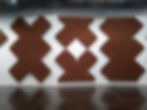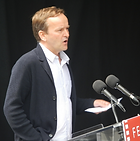Featured Sculptors & Sculptures
The development of site-specific dance related to the incredible sculptures at Grounds For Sculpture is a cornerstone of The Outlet Dance Project. We are committed to deep explorations of interdisciplinary collaboration and conversation. Below is information about the artists whose work this year's choreographers have been inspired by and are working with, along with photos of the sculptures themselves.
*Unless noted, all photos of sculptures here are by donia salem.










EMILIE BENES BRZEZINSKI
Born in 1932 in Geneva, Switzerland, Emilie Benes Brzezinski immigrated to the United States and grew up in California. She graduated from Wellesley College with a degree in Art History in 1953.
Brzezinski began her art career in the 1970s working with a variety of media, including resins, latex, and wood fiber. Her expressive themes always related to nature. Eventually, she shifted focus to creating monumental wood sculpture, using a chain saw and ax to carve towering forms that breathed new life into felled trunks.
During the last two decades, Brzezinski has had several gallery and museum installations both in the United States and overseas. Many of her works are in the Czech Republic, the country of her family's origin. There, "Prague Titans" gazes upon the Vltava River, and a more restrained installation, "Broken Blocks" can be seen in the National Gallery in Prague. In the United States, her bronze "Arch in Flight" stands just two blocks from the White House in front of the Federal Reserve building on New York Avenue, and her most monumental work to date, "Lament", greets visitors in the front circle of the Kreeger Museum. Outside the nation's capital, Brzezinski sculptures can be found in Chicago at The Society for Arts as well as in New Jersey at the respected Grounds for Sculpture park.
Brzezinski continues to work in her Northern Virginia studio that she built in the 1980s. www.thelureoftheforest.com

WALTER DUSENBERY
Most of Dusenbery’s artistic career has been devoted to making sculpture in stone: marble, travertine, limestone, and granite, precisely assembled as coherent sculptural forms. His sculptures are monumental in scale. Their formal vocabulary takes classical architecture’s visual language as a starting point, merging architecture and sculpture. Dusenbery studied classical dance at the San Francisco Ballet and, later, modern dance in New York City at Juillard with Jose Limon, Martha Graham, and May O’Donnell. Dusenbery believes his dance training informs a human- scaled kinesthetic relationship to his sculpture and its space. In 1960, he enrolled in the San Francisco Art Institute to study ceramics. He was an instructor of ceramics at the University of California Extension, San Francisco, during this period, eventually receiving an MFA from the California College of Arts and Crafts in sculpture, receiving an MFA in 1970. He traveled to Tokyo after graduation, where he met the Japanese sculptor Tsutomu Hiroi who suggested that his work is perfect for stone. Hiroi introduced Dusenbery to the granite carving village of Aji on the island of Shikoku, and his first carved granite sculptures were completed here. Isamu Noguchi befriended Dusenbery and invited him to visit the stone working areas of Italy, to better understand the Western tradition. Once in Italy, he met Henry Moore and Marino Marini, who were both in residence at the time and had studios on either side of Dusenbery. These artists influence him to begin enlarging models to full scale sculptures. While also pursuing his own work, from 1971-1973 Dusenbery assisted Noguchi with a large public project, the Detroit Civic Plaza and Fountain, and also assisted him with the development and production of small Noguchi drawings to a collection of full-sized stainless steel sculptures. Also in 1973, Dusenbery was offered a one-man exhibition of white marble sculptures at the Bonino Gallery, NYC. Over the years he has exhibited at many NYC galleries: A. M. Sachs, Hamilton, Siegeltuch, and Fendrick. He also had museum shows at the Nassau County Museum of Art, 1981; Yorkshire Sculpture Park in England, 1981; and University of Virginia Museum of Art; 1983. Dusenbery was visiting sculptor at Harvard’s Graduate School of Design from 1980-1988. In 1988, after splitting time in New York City and Pietrasanta, he decided to relocate to upstate New York to build a home and studio in 1988. That was also the same year he received a large commission to build a fountain for the Fulton County Building in Atlanta. Following the completion of ‘Atlantacropolis’, Dusenbery withdrew from the gallery world and refocused his energy on site-specific commissions. Seeking a large scale stone studio for projects closer to home, he discovered there were none. In 1995 he approached sculptor and patron of sculpture, J. Seward Johnson Jr., with the idea of creating a state-of-the-art stone carving studio, so that American sculptors would not have to travel aboard to realize their work. Johnson agreed to assist with the creation of a facility, if Dusenbery would direct it. The Stone Division opened in 1996 and featured the most advanced computer numerically controlled (CNC) stone-milling machines ever built for sculpture fabrication. The studio also had the ability to digitally scan three-dimensional forms for enlargement. Dusenbery continued to direct and produce work at The Stone Division until 2003. When it became reformed as the not- for-profit Digital Stone Project in 2004, Dusenbery was named president and remained in that position until 2008. More recently, Dusenbery received the commission for the entrance to the Presidential Trauma Center serving the Northwest in 2009. The entrance relief is 75’ long and 10’ high titled: In the Garden, a metaphor for man’s work with nature. It was installed in 2011 at the Harborview Hospital in Seattle, Washington.
More at www.walterdusenbery.com.

PETER WOYTUK

JAMES CARL
Based in Toronto, James Carl is one of the city’s leading artists. He creates small- and large-scale sculpture, made from a wide range of materials, from cardboard to marble, to venetian blinds. In the early 1990s Carl entered the art scene in Montreal by crafting expensive consumer goods (washing machines, stoves) from inexpensive materials such as found cardboard, only to place the finished sculptures back on the streets where their materials were originally retrieved. In a subsequent body of work, Carl carved replicas of disposable electronics out of marble – a traditional sculptor’s material with connotations of permanence. Most recently, Carl constructs large-scale, amorphous sculptures by intricately weaving brightly coloured venetian blinds in a series titled jalousie.
Carl has exhibited extensively both nationally and internationally. Most recently, the first major survey of his work, entitled do you know what, was presented at the Justina M. Barnicke Gallery at the University of Toronto, the Cambridge Galleries Queen’s Square and the MacDonald Stewart Art Centre in Guelph. Other recent shows include: jalousie at Galerie Heinz-Martin Weigand in Karlsruhe, Germany; negative spaces at Florence Loewy in Paris; plot at Vancouver’s Contemporary Art Gallery, and bottom feeder at Mercer Union in Toronto. Carl earned his MFA from Rutgers University and has degrees from McGill, the University of Victoria and the Central Academy of Fine Art in Beijing. His work is in public and private collections across North America and Europe. Currently, Carl is an Associate Professor of Studio Art at the University of Guelph.

SARAH HAVILAND
Sarah Haviland’s abstract-figurative sculptures and public installations have been exhibited in galleries, parks, museums, and educational settings, including commissions at Grounds for Sculpture, Pratt Sculpture Park, and NYU Langone Medical Center. Awards include a Creativity Grant from the National Endowment for the Arts, fellowships from the New York and New Jersey State Arts Councils, and residencies at Sculpture Space, Skowhegan, and Yaddo. Her work reveals particular interests in images of birds and avian mythology, human and natural gesture, women, mirrors, and local history. Sarah Haviland earned a BA from Yale University and an MFA from Hunter College. She lectures independently and teaches sculpture at Borough of Manhattan Community College, CUNY.
More information at www.sarahhaviland.com

DANIEL KAINTZ
For fifteen years, between 1964 to1980, Daniel Kainz apprenticed and came to master stone carving as an employee of the Wenz Company, Inc. in Allentown, PA. Here he developed new sandblasting techniques, studied with master stone carvers from Italy, and created his early stone sculptures. Since 1991, Kainz has been the general manager of the sculpture division at Wenz Company, Inc. Having apprenticed with artist Karen Mikolas, Kainz’s expertise encompasses wood carving and glass work as well. Kainz has participated in numerous exhibitions throughout the United States and his work is included in various public and private collections including: Albright College, reading, PA; Widener University Law School, Chester, PA; Lincoln University, Lincoln, PA; Lehigh Valley Hospital, Allentown, PA; Philip and Muriel Berman Museum of Art located at Ursinus College, Collegeville, PA.

ELIZABETH STRONG-CUEVAS
Strong-Cuevas studied at the prominent and long established Art Students League of New York, learning wood and stone carving under the tutelage of John Hovannes in the mid-1960s. She later expanded her approach to creating works and began to work in plaster, this time with Toto Meylan. Besides bronze, some of her works have been cast in stainless steel and aluminum. Careful attention is paid to the surface of her sculptures; and, according to the medium, some are polished to a gleaming finish, some are brushed, and others are treated with a patina. Sculptures by Strong-Cuevas have been exhibited in one-person shows in New York City and the Hamptons on Long Island. In addition, her works have been represented in group exhibitions in galleries in the United States and Europe, such as The Bruce Museum in Greenwich and the Kouros Gallery in Ridgefield, both in Connecticut; The Parrish Art Museum in Southampton, NY; Shidoni Contemporary near Santa Fe, NM; Biennale III and IV held in MonteCarlo; and the Tolman Collection in Singapore.
More information on this artist can be found at www.sc-sculpture.com
Born in 1958, Peter Woytuk was introduced to the artistic considerations of architecture by his father. Peter Woytuk, Sr., who took the family on a six-month tour of Europe, concentrating on significant architectural sites. Woytuk went on to major in art at Kenyon College in Ohio, focusing on photography; however, creating welded sculpture captured his interest and upon graduating in 1980, he took an apprenticeship with sculptor Philip Grausman. While working for Grausman, he absorbed a sense of the “convex and concave” form. He also developed the technical knowledge and skills needed to create cast sculpture. By 1986, Woytuk was showing his work in solo exhibitions and has continued to garner attention for his work. In 1998, a commission from the North Carolina Zoological Society resulted in four life-size bronze elephants for the park’s entrance. He is represented by Owings-Dewey Fine Art in Santa Fe, NM; Anne Reed Gallery in Ketchum, ID; and Denise Roberge Gallery in Palm Desert, CA. Woytuk and his wife divide their time between working at their foundry in Thailand and working in Santa Fe, NM. www.woytuk.com.





















